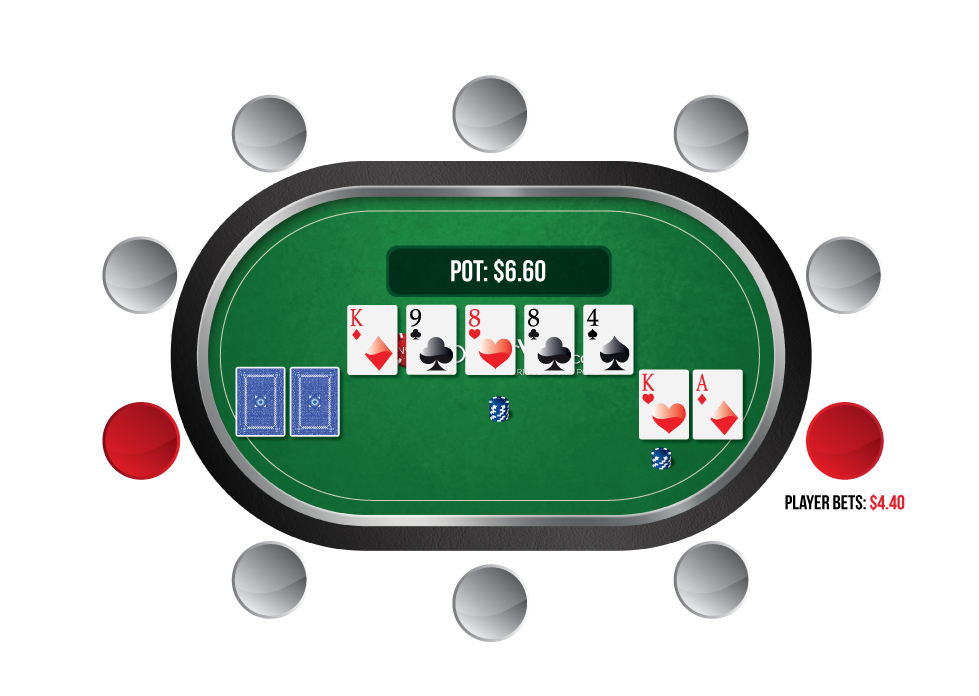How to deal with a situation where our flop bet is raised? There is no one answer to this question, and so much will depend on the limits you play, general tendencies of the your opponents (population reads) as well as specific reads and stats of a villain. The advice contained in here should give you a good general idea about different situations.
It's a common situation,

we fire a bet on the flop and get raised. Should we continue or should we give our opponent credit and fold? In some cases, especially at the lower limits it may feel like we are folding all of the time and have a leak. But is this really the case?
The Situation
Initially we need to establish the exact situation we are facing because not all flop raises are the same.
1. Positions
The first relevant factor are the positions of the players involved. Assuming we are the open-raiser, the earlier the position we are in, the tighter our opponents cold-calling range is likely to be. We are perceived as stronger when we open in early and are less likely to be raised or check/raised.
It's not impossible we will be bluff-raised on the flop after opening from EP or MP, but most players have a tendency to bluff more when we open from BTN, CO, SB. Our opening range is wider which often leads to more aggression from our opponent.
2. Number of Players
This is absolutely crucial, especially at the lower limits. As soon as there are 3 or more players on the flop, the chances of bluff-raises occurring dramatically decrease. It can actually be good to throw out some flop-raises multi-way for this reason, we represent much more strength than in the heads-up situation. Players at slightly higher limits understand this and will have a default flop bluff-raising range in multi-way pots. In lower limits we can likely automatically fold any non-premium when facing a raise multi-way.
We only know our true price for drawing if we are the last to act on a certain round.
Assuming we hold some type of draw, facing a raise in multi-way pots can be advantageous. Perhaps we don't quite get the right price in a HU situation to continue, but with the extra player/s in the pot we now have a pretty comfortable call. Naturally in such situations we also need to consider if we are closing the action after we face a raise. We only know our true price for drawing if we are the last to act on a certain round. If we call a flop-raise and there are still players to act behind us, we may face additional action and get blown off our draw.
3. Preflop Action
So far we have primarily been referring to single-raised pots. Bluff-raises can occur in any situation though. 3bet pots, 4bet pots etc. For the most part it seems the average player is less inclined to have a bluff-raising range in 3bet or 4bet pots compared to their propensity to bluff in single-raised or
limped pots. For the majority of players there is a point where the pot is large enough that they will start to play the game honestly based on the strength of their holding. As a rough guide, the more bloated the pot preflop, the less we should expect bluff-raises postflop. This rule wont apply to all players though, as soon as we have specific reads we can start making a judgement on a player-by-player basis.
4. Initiative
A player does not necessarily have to be the cold-caller preflop and face a flop c-bet in order to bluff-raise the flop. They might actually be the preflop aggressor, decide to skip their cbet OOP and go for a check/raise. In reality good players should be doing this almost as often as they check/raise as the cold-caller. In practice this simply doesn't happen. The vast majority of players are not at the level where they think about check/raise bluffing as the PFR.
If they want to bluff in this situation they will generally just fire a cbet. So check/raises from the PFR are rare overall and generally represent nutted holdings. Players are often far more creative with strong value-hands than they are with bluffs. So usually if we see a player taking a strange unorthodox line, it's slightly more likely they are getting tricky with a value-hand as opposed to bluffing.
5. Stack Sizes
It's hopefully easy to see

why this could have a large impact on the correct decision when facing a raise. If our opponent has a very shallow stack it might be impossible to continue with certain draws which we have the correct
implied-odds to call if our opponent had a deep stack. Conversely it might be reasonably straight-forward to continue with an overpair vs a shallow-stacked opponent, which we might consider folding if our opponent was deep and we hence suffered from reverse implied-odds.
We need to weigh up all of these factors simultaneously if we want to gauge the strength of a flop raise from an unknown.
For example imagine UTG opens, MP 3bets, CO calls, UTG calls, the rest fold. UTG checks, MP bets, CO calls, UTG check/raises. UTG ticks a ton of the boxes for being super strong here. He opens in early, it's a 3bet pot, the flop is multi-way. We should be able to make some big laydowns in this situation.
Now imagine BTN opens, BB calls. BTN cbets and BB check/raises. We have no reason to necessarily think an unknown is super strong (more on this later). We are probably continuing with at least top-pair+ maybe even some back-door draws depending on our exact estimation of villain's range.
Exploitative Play
The best decisions in any NLHE situation are going to be the exploitative ones. We should be making use of our opponents “flop-raise-vs-cbet” stat. It's recommended that this is actually one of the stats included in our main HUD window and not buried in a popup somewhere. Inside the popup we can break it down in the following ways.
It's estimated that we hit the flop hard about 10% of the time. So anything below a 10% check/raise could be considered strong.
- raise-vs-cbet-IP
- raise-vs-cbet-OOP (check/raise)
- raise-vs-cbet-TOTAL
- Overall flop-raise TOTAL (independent of initiative)
- Overall flop-raise IP
- Overall flop-raise OOP
- X/r after skip flop cbet (we can potentially place this in our cbet popup if preferred)
- The above stats for 3bet/4bet pots.
It's estimated that we hit the flop hard
about 10% of the time. So anything below a 10% check/raise could be considered strong. However we also need to factor in that many players are aware that it is not considered correct strategy to raise premium holdings on a dry
texture, only the drawy ones. So we should discount slightly our idea of which flop-raise % constitutes a nutted range. Let's say
- 6% is probably the stone-cold nuts.
- 6-11% reasonably strong
- 12-17% good/aggressive (more bluffs than value, but this is correct strategy)
- 18% + You are probably being bluffed
However it's important to keep in mind that these numbers can't be considered in isolation. We first need to know what type of
range our opponent gets to the flop with. Imagine our opponent cold-calls 100% of hands preflop. Should we assume that because he is only raising the flop 6% of the time that he has the nuts? Not at all, that's actually loose/aggressive given that he gets to the flop with such a wide range.
Or imagine a guy who only calls PP's preflop. Should we assume that he is good/aggressive/balanced if he raises flop 12% of the time. Not at all, remember that we flop a set 12.5% of the time. He can easily reach 12% without ever bluffing if he doesn't understand how to play his sets on different board textures.
We should also make use of the following advanced statistics to help us with our flop decision.
- Barrel-turn-after-raise-flop
- Barrel-river-after-raise-flop-bet-turn
- Raise-fold-flop-IP-OOP-TOTAL
The first two stats here consider future play and help us to make an exploitative decision based on this. If our opponent's have a tendency to continue firing after they raise the flop we should generally be continuing with a tighter range on the flop. If they have tendency to check turn after they raise the flop we can often defend with a wider range knowing that we are either going to get a free card more often or the opportunity to take down the pot more often after our opponent checks.
The final stat there shows how often our opponent folds to 3bets. If this is sufficiently high we can consider turning some of our draws/back-door-draws into 3bet bluffs.
Population Reads
Ideally we shouldn't be

folding more than about 50% of the time to a regular-sized flop-raise. However
population tendencies can influence the correct value of this stat. As a rough trend players are less inclined to bluff flops the lower in limits we go. At higher limits the majority of the population is aware that we should be bluffing flops aggressively. At micro-limits there are plenty of players who never bluff-raise flops and only raise with something decent.
If we know our opponent is never bluffing then we'd obviously play quite tightly facing a raise. Our fold-cbet-to-raise could end up being in the 60% region. We described a situation earlier where we opened on the BTN and got check/raised. We mentioned that we have no reason to believe our opponent is that strong. We should still approach the situation with a measure of caution at lower limits however, perhaps he is one of these players that simply does not bluff-raise flops.
Bet Sizing
So far we have mentioned nothing about
bet-sizing and this should obviously influence our continuing range.
The standard sizing for a flop-raise will be about 3x in singe-raised-pot and about 2.2x in a 3bet pot. Deviations from these sizings can often give us a clue about our opponents holdings.
Way larger than standard – First thing we can establish when facing any non-standard bet is that our opponent is probably not a regular and doesn't necessarily show up with standard ranges in most situations.
Large flop-raises are generally an indication that our opponent is not bluffing. It doesn't make sense to bet so large as a bluff – the risk/reward ratio is very poor. Our opponent is not necessarily thinking in these terms however – but generally we should give more credit to unusually large flop-raises.
Way smaller than standard – For example, perhaps we face a min-raise in a single-raised-pot. This usually won't be a bluff either but will be considerably weaker and more merged than the regular sized flop-raise. As a rule-of-thumb it's recommended never to fold any top-pair to a flop min-raise.
Large flop-raises are generally an indication that our opponent is not bluffing. It doesn't make sense to bet so large as a bluff – the risk/reward ratio is very poor.
Defending vs Aggressive Opponents
So we have run into a player who appears to be raising flops aggressively with a balanced range. What will our continuing range look like.
1.Calling
- We call with some mid-strength hands not strong enough to 3bet
- We slowplay some premiums that are strong enough to 3bet
- We defend with some back-door draws and regular draws which we will us as bluffs on later streets
2. Raising
- We 3bet our premiums for value (apart from those we slowplay)
- We 3bet some nutted draws to stack off with
- We 3bet some backdoor draws and weak draws which we can fold to a 4bet but will continue bluffing with if just called and we turn equity
At higher limits we can jump straight into this defending mode by default. At lower limits we can essentially just cut out all back-door draws without a decent read that our opponent is playing aggressively. 3bet bluffing is also going to be less effective in general at lower limits since the average flop-raising range is much stronger.
 we fire a bet on the flop and get raised. Should we continue or should we give our opponent credit and fold? In some cases, especially at the lower limits it may feel like we are folding all of the time and have a leak. But is this really the case?
we fire a bet on the flop and get raised. Should we continue or should we give our opponent credit and fold? In some cases, especially at the lower limits it may feel like we are folding all of the time and have a leak. But is this really the case? why this could have a large impact on the correct decision when facing a raise. If our opponent has a very shallow stack it might be impossible to continue with certain draws which we have the correct implied-odds to call if our opponent had a deep stack. Conversely it might be reasonably straight-forward to continue with an overpair vs a shallow-stacked opponent, which we might consider folding if our opponent was deep and we hence suffered from reverse implied-odds.
why this could have a large impact on the correct decision when facing a raise. If our opponent has a very shallow stack it might be impossible to continue with certain draws which we have the correct implied-odds to call if our opponent had a deep stack. Conversely it might be reasonably straight-forward to continue with an overpair vs a shallow-stacked opponent, which we might consider folding if our opponent was deep and we hence suffered from reverse implied-odds. folding more than about 50% of the time to a regular-sized flop-raise. However population tendencies can influence the correct value of this stat. As a rough trend players are less inclined to bluff flops the lower in limits we go. At higher limits the majority of the population is aware that we should be bluffing flops aggressively. At micro-limits there are plenty of players who never bluff-raise flops and only raise with something decent.
folding more than about 50% of the time to a regular-sized flop-raise. However population tendencies can influence the correct value of this stat. As a rough trend players are less inclined to bluff flops the lower in limits we go. At higher limits the majority of the population is aware that we should be bluffing flops aggressively. At micro-limits there are plenty of players who never bluff-raise flops and only raise with something decent. 

